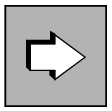With the DADM RQ call, openUTM supplies information about the messages in a queue. For every message, openUTM provides the job ID, the user ID of the job submitter, the origination time of the message and, in the case of time-controlled messages (DPUT messages), the earliest execution time. It also informs you whether a positive or negative confirmation job exists.
For a DADM RQ call, you enter the name of the recipient in the kclt field of the KB parameter area whose message queue is to be read. In the case of service-controlled queues, the type is also required in the kcqtyp field.
You can also output information about all the messages in a message queue or restrict the information output to just one message in the queue.
In the kcrn field of the parameter area, you enter the job ID of the message for which openUTM is to provide information. If you write any blanks in kcrn, openUTM informs you about the first message in the message queue for the recipient kclt.
The procedure for reading information about all messages in a message queue is as follows:
In the first DADM RQ for a recipient, instead of a job ID you enter blanks in the kcrn field of the parameter area.
UTM returns information about the first message in the message queue of the recipient. If at least one other message exists for the same recipient, openUTM writes the job ID of the next message in the queue to the kcrmf field of the KB return area.
You call DADM RQ once again and write the job ID which openUTM returned in the kcrmf field to the kcrn field of the KB parameter area.
UTM provides information about the second message and returns the job ID of the next message in the queue if another message exists.
This means that the message queue can be processed sequentially. When the information about the last message in the queue is read, UTM returns blanks to the kcrmf field.
A data structure exists for information returned from DADM RQ which you can place over the message area. The C data structure is called kc_dadm and is part of the header file kcdad.h. The corresponding COBOL data structure is called KCDADC.
See section "KDCDADM INFORM" in chapter "INFORM - Display information about message queues and messages". |

